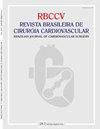Botulinum Toxin Injection into Epicardial Fat Pads: A Promising Potential Modality for Prevention of Postoperative Atrial Fibrillation After Cardiac Surgery
IF 1.2
4区 医学
Q4 CARDIAC & CARDIOVASCULAR SYSTEMS
Revista Brasileira De Cirurgia Cardiovascular
Pub Date : 2019-12-01
DOI:10.21470/1678-9741-2019-0309
引用次数: 3
Abstract
Despite developing new standards and advances in anesthetic and surgical techniques, postoperative atrial fibrillation (POAF) is one of the most frequent complications and a significant unsolved clinical problem after cardiac surgery[1]. Occurrence of POAF is associated with significant increased risk of long-term mortality, morbidity, and long intensive care unit (ICU) and hospital stays, which consequently impose additional cost on both health system and patient[2]. Considering the potential significant adverse effects of POAF in patients undergoing cardiac surgery and the limited efficacy of current preventive strategies, concerted efforts to identify and implement new preventive strategies are necessary[1,2]. Recently, injection of botulinum toxin into epicardial fat pads in patients undergoing cardiac surgery has been suggested as a promising modality for prevention of POAF. In a study by Pokushalov et al.[3], it has been shown that 50 U botulinum toxin injection, at four major epicardial fat pads, during surgery in patients undergoing coronary artery bypass grafting (CABG) provided considerable atrial tachyarrhythmia suppression, in both early and one-year followups[3]. Also, a three-year follow-up of this study indicates a sustained and significant reduction in atrial fibrillation (AF) incidence and burden, along with reduction in patients' hospitalizations. Besides, no serious adverse events related to injection of botulinum toxin for prevention of POAF after CABG have been reported[4]. Suppression of atrial autonomic remodeling has been suggested as a potential mechanism of botulinum toxin injection for prevention of POAF[34]. Another study by Waldron et al.[5] showed that injection of 50 U of botulinum toxin into each five epicardial fat pads (immediately after beginning of cardiopulmonary bypass) in patients undergoing cardiac surgery reduced the incidence of POAF compared to placebo (36.5% and 47.8%, respectively), however this difference was not statistically significant. Also, no significant differences were seen between length of hospital stay and occurrence of adverse effects in patients who received botulinum toxin injection or placebo[5]. In this study, patients who underwent CABG or valve surgery or combined CABG and valve surgery were included; whereas in Pokushalov et al.[3] one-year and three-year follow-up studies[4], only CABG patients were included and evaluated. Additionally, the left atrial sizes, as a marker of atrial structural remodeling, which commonly is associated with increased risk for AF, were considerably different between these studies (3.9±0.6 and 3.9±0.7 cm vs. 4.7±0.8 and 4.8±0.6, respectively). These issues may be possible explanations for the inconsistent results between studies. In sum, it seems that botulinum toxin injection into epicardial fat pads may be considered as a potentially promising and safe modality for prevention of POAF after cardiac surgery. However, further well-designed studies will be required to investigate the efficacy of this preventive modality for POAF in patients undergoing cardiac surgery, after controlling the potential confounding factors such as type of surgery, left atrial sizes, dose and site of injection of botulinum toxin, etc.肉毒毒素注射心外膜脂肪垫:预防心脏手术后房颤的一种有前景的潜在方式
尽管在麻醉和外科技术方面有了新的标准和进步,但术后心房颤动(POAF)是心脏手术后最常见的并发症之一,也是一个尚未解决的重要临床问题[1]。POAF的发生与长期死亡率、发病率、长期重症监护室(ICU)和住院的风险显著增加有关,从而给卫生系统和患者带来额外成本[2]。考虑到POAF对接受心脏手术的患者可能产生的重大不良影响,以及当前预防策略的有限疗效,有必要共同努力确定和实施新的预防策略[1,2]。最近,在接受心脏手术的患者的心外膜脂肪垫中注射肉毒杆菌毒素被认为是预防POAF的一种很有前途的方式。Pokusalov等人[3]的一项研究表明,在接受冠状动脉搭桥术(CABG)的患者手术期间,在四个主要心外膜脂肪垫处注射50U肉毒杆菌毒素,在早期和一年的随访中都能显著抑制心房快速性心律失常[3]。此外,这项研究的三年随访表明,心房颤动(AF)的发病率和负担持续显著降低,患者住院人数也有所减少。此外,目前尚无与CABG后注射肉毒杆菌毒素预防POAF相关的严重不良事件的报道[4]。抑制心房自主神经重塑已被认为是肉毒杆菌毒素注射预防POAF的潜在机制[34]。Waldron等人[5]的另一项研究表明,与安慰剂(分别为36.5%和47.8%)相比,在接受心脏手术的患者中,每五个心外膜脂肪垫中注射50 U肉毒杆菌毒素(心肺转流开始后立即注射)可降低POAF的发生率,但这一差异在统计学上并不显著。此外,在接受肉毒杆菌毒素注射或安慰剂治疗的患者中,住院时间和不良反应发生率之间没有显著差异[5]。在这项研究中,接受CABG或瓣膜手术或CABG和瓣膜联合手术的患者包括在内;而在Pokusalov等人[3]的一年和三年随访研究[4]中,仅纳入并评估了CABG患者。此外,作为心房结构重塑的标志物,左心房大小通常与房颤风险增加有关,在这些研究之间差异很大(分别为3.9±0.6和3.9±0.7 cm,而4.7±0.8和4.8±0.6)。这些问题可能是研究结果不一致的原因。总之,将肉毒杆菌毒素注射到心外膜脂肪垫中似乎可以被认为是一种潜在的、有前途的、安全的预防心脏手术后POAF的方法。然而,在控制了潜在的混杂因素(如手术类型、左心房大小、肉毒杆菌毒素的剂量和注射部位等)后,还需要进一步精心设计的研究来研究这种预防方式对心脏手术患者POAF的疗效。
本文章由计算机程序翻译,如有差异,请以英文原文为准。
求助全文
约1分钟内获得全文
求助全文
来源期刊

Revista Brasileira De Cirurgia Cardiovascular
CARDIAC & CARDIOVASCULAR SYSTEMS-SURGERY
CiteScore
2.10
自引率
0.00%
发文量
176
审稿时长
20 weeks
期刊介绍:
Brazilian Journal of Cardiovascular Surgery (BJCVS) is the official journal of the Brazilian Society of Cardiovascular Surgery (SBCCV). BJCVS is a bimonthly, peer-reviewed scientific journal, with regular circulation since 1986.
BJCVS aims to record the scientific and innovation production in cardiovascular surgery and promote study, improvement and professional updating in the specialty. It has significant impact on cardiovascular surgery practice and related areas.
 求助内容:
求助内容: 应助结果提醒方式:
应助结果提醒方式:


